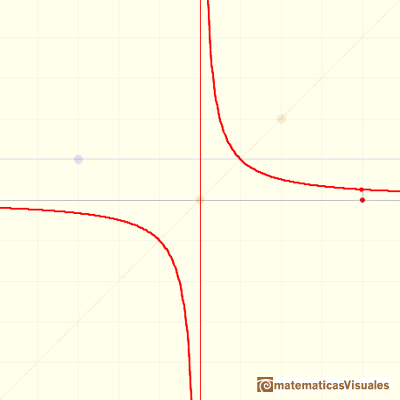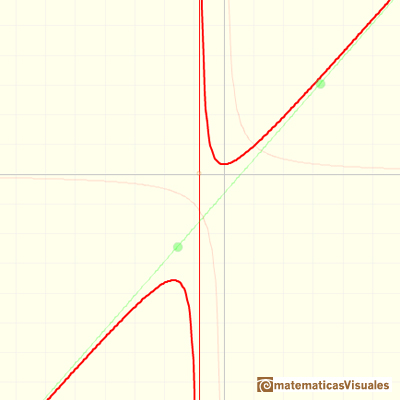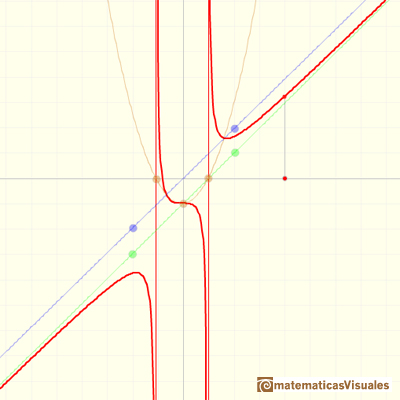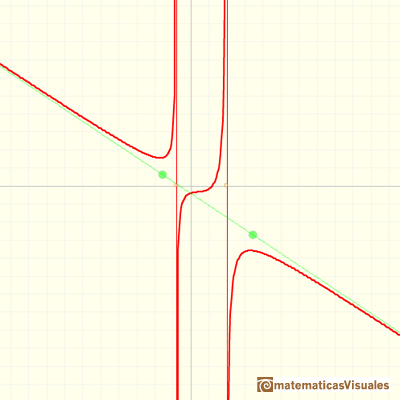
In this page we are going to study deeply the end behavior of rational functions. It is to say how it is the function for large |x| (x positive or negative) or how the function behaves when 'x tends to infinity' (positive or negative).
We have already seen that when the degree of the denominator is bigger than the degree of the numerator (Proper rational functions) then the rational function has a horizontal asymptote y = 0 (the x-axis). For example, this is the case of the equilateral hyperbola.

If the degree of the numerator is equal or bigger than of the denominator this rational function is improper. You can divide the numerator of a rational function by its denominator and get a polynomial quotient plus a polynomial remainder term whose degree is less than of the denominator. The remainder divided by the denominator is a Proper rational function and contributes very little to the y-values of the rational function for large |x|.

We have already seen several examples of Improper rational functions but only when the degree of the denominator is equal than the degree of the numerator. In those cases, if you divide you get a quotient that is a number. Then you can write the rational function as a number plus a proper rational function.

With that number (that you can calculate dividing only the leadings terms of the numerator and denominator) you can write the horizontal asymptote (an horizontal straight line, a constant function).

This is the equation of the horizontal asymptote:
When the degree of the numerator is higher than the degree of the denominator there is no horizontal asymptote.
In this page we are going to study the case when the degree of the numerator is greater than the degree of the denominator but it is greater only by one.
As before, you can divide numerator by denominator and, using the quotient and the remainder, you can write the rational function as a polynomial plus a proper rational function. In this cases, this polynomial is a degree 1 polynomial. This straight line controls the behavior of the rational function when the module of x is big (then the proper rational function is very small).
The quotient polynomial Q(x) is linear, Q(x)=ax+b, then y=ax+b is called an slant or oblique asymptote for f(x).
If the degree of the numerator is exactly one more than the degree of the denominator, the end behavior of this rational function is like an oblique linear function. The graph of the rational function attempts to imitate an oblique straight line in the domain's positive or negative extremes. In these cases we say that the rational function has an oblique (or slant) asymptote.
The first case is when the numerator has degree 2 and the denominator has degree 1:

In this case, this is the equation of the oblique asymptote:
In the first mahtlet you could play with the three elements of this kind of rational function: a degree 1 polynomial (in green, a straight line), the numerator (a number, in blue a horizontal line) and the denominator (a straight line, in orange)
For example:

The formula for the previous graph is:
In this case, this is the equation of the oblique asymptote:
Another example:

In the next mathlet you can play with rational functions that has a degree 3 polynomial in the numerator and the denominator has degree 2.

As before, the equation of the oblique asymptote is:
The three elements of this kind of rational function are: a degree 1 polynomial (in green, a straight line), the numerator (in blue, a straight line) and the denominator (a parabola, in orange):
For example:

The formula for the previous graph is:
The equation of the oblique asymptote is:
Another example:

REFERENCES
 NEXT
NEXT
 PREVIOUS
PREVIOUS
MORE LINKS

































